Psyche (spacecraft)
Psyche (/ˈsaɪki/ SY-kee) is a NASA space mission launched on October 13, 2023 to explore the origin of planetary cores by orbiting and studying the metallic asteroid 16 Psyche beginning in 2029.[8] NASA's Jet Propulsion Laboratory (JPL) manages the project.
 An illustration of the Psyche spacecraft | |||||||||||
| Mission type | Asteroid orbiter | ||||||||||
|---|---|---|---|---|---|---|---|---|---|---|---|
| Operator | |||||||||||
| COSPAR ID | 2023-157A | ||||||||||
| SATCAT no. | 58049 | ||||||||||
| Website |
| ||||||||||
| Mission duration | Cruise: 5 years, 10 months (planned)[1] Science: 21 months in orbit | ||||||||||
| Spacecraft properties | |||||||||||
| Spacecraft | Psyche | ||||||||||
| Manufacturer | Maxar Technologies[2] | ||||||||||
| Launch mass | 2,608 kg (5,750 lb) [3] | ||||||||||
| Dry mass | 1,648 kg (3,633 lb) [4] | ||||||||||
| Payload mass | 30 kg (66 lb) | ||||||||||
| Power | 4.5 kW | ||||||||||
| Start of mission | |||||||||||
| Launch date | October 13, 2023[5][6] | ||||||||||
| Rocket | Falcon Heavy[7] | ||||||||||
| Launch site | Kennedy Space Center, LC-39A | ||||||||||
| Contractor | SpaceX | ||||||||||
| 16 Psyche orbiter | |||||||||||
| Orbital insertion | August 2029[1] | ||||||||||
| |||||||||||
 Psyche mission patch | |||||||||||
16 Psyche is the heaviest known M-type asteroid, and may be an exposed iron core of a protoplanet, the remnant of a violent collision with another object that stripped off its mantle and crust. On January 4, 2017, the Psyche mission was selected for NASA's Discovery #14 mission.[9] It was launched atop a SpaceX Falcon Heavy rocket.[10]
History
Psyche was submitted by Lindy Elkins-Tanton, a principal investigator at Arizona State University, as part of a call for proposals for NASA's Discovery Program that closed in February 2015. It was shortlisted on September 30, 2015, as one of five finalists and awarded US$3 million for further concept development.[8][11]
On January 4, 2017, Psyche was selected for the 14th Discovery mission, with launch set for 2023.[12] In May 2017, the launch date was moved up to target a more efficient trajectory, to July 2022 aboard a SpaceX Falcon Heavy launch vehicle with a January 31, 2026 arrival, following a Mars gravity assist on May 23, 2023.[13]
In June 2022 NASA found that the late delivery of the testing equipment and flight software for the Psyche spacecraft did not give them enough time to complete the required testing, and decided to delay the launch, with future windows available in 2023 and 2024 to rendezvous with the asteroid in 2029 and 2030, respectively.[14]
On October 28, 2022, NASA announced that Psyche was targeting a launch period opening on October 10, 2023, which would correspond with an arrival at the asteroid in August 2029.[1]
On April 18, 2023, JPL's mission page for Psyche was updated to reflect a new launch date of October 5, 2023.[15] On September 28, 2023, the launch was again delayed to no earlier than October 12, 2023, due to an unspecified issue with the spacecraft.[16] The launch was further delayed to October 13, 2023, due to bad weather.[17]
An independent review of the delays at JPL reported in November 2022 found understaffing, insufficient planning, and communications issues among engineers and with management. The VERITAS Venus mission was delayed to free up staff to focus on Psyche.[18]
Target
16 Psyche is the heaviest known M-type asteroid, and may be an exposed iron core of a protoplanet,[19] the remnant of a violent collision with another object that stripped off its mantle and crust.
Recent studies show that it is "a mixed metal and silicate world".[20] Another study considers it to be either a metal core of a protoplanet or "a differentiated world with a regolith composition … peppered with localized regions of high metal concentrations".[21] Radar observations of the asteroid from Earth indicate an iron–nickel composition.[22]
Mission overview
The Psyche spacecraft is designed with solar electric propulsion,[23][24] and the scientific payload includes a multispectral imager, a magnetometer, and a gamma-ray spectrometer.[24][25]
The mission is designed to perform 21 months of science. The spacecraft was built by NASA Jet Propulsion Laboratory (JPL) in collaboration with SSL (formerly Space Systems/Loral) and Arizona State University.[1][26]
It was proposed that the rocket launch might be shared with a separate mission named Athena, that would perform a single flyby of asteroid 2 Pallas, the third-largest asteroid in the Solar System.[27]
In May 2020, it was announced that the Falcon Heavy carrying Psyche would include two smallsat secondary payloads to study the Martian atmosphere and binary asteroids, named EscaPADE (Escape and Plasma Acceleration and Dynamics Explorers) and Janus respectively,[13] but in September 2020, the EscaPADE Mars atmosphere probe was removed from the plan.[28]
Janus was later removed from the Psyche mission as well on November 18, 2022, after an assessment determined that it would not be on the required trajectory to meet its science requirements as a result of Psyche's new launch period.[29]
Science goals and objectives
Differentiation is a fundamental process in shaping many asteroids and all terrestrial planets, and direct exploration of a core could greatly enhance understanding of this process. The Psyche mission aims to characterize 16 Psyche's geology, shape, elemental composition, magnetic field, and mass distribution. It is expected that this mission will increase the understanding of planetary formation and interiors.
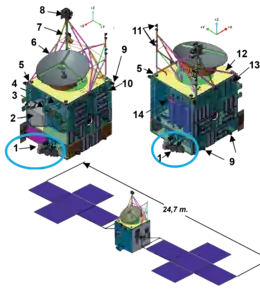
1. Hall-effect thrusters
2. Optical telecommunications system
3. Star trackers
4. Low-gain antenna
5. Sun sensor
6. X-band High-gain antenna
7. Neutron spectrometer
8. Gamma-ray spectrometer
9. Cold gas thrusters
10. -Y Panel
11. Magnetometer
12. Top deck
13. +Y Panel
14. Multispectral imagers (x2)
Specifically, the science goals for the mission are:[31]
- Understand a previously unexplored building block of planet formation: iron cores.
- Look inside terrestrial planets, including Earth, by directly examining the interior of a differentiated body, which otherwise could not be seen.
- Explore a new type of world, made of metal.
The science questions this mission aims to address are:[19][31]
- Is 16 Psyche the stripped core of a differentiated planetesimal, or was it formed as an iron-rich body? What were the building blocks of planets? Did planetesimals that formed close to the Sun have very different bulk compositions?
- If 16 Psyche was stripped of its mantle, when and how did that occur?
- If 16 Psyche was once molten, did it solidify from the inside out, or the outside in?
- Did 16 Psyche produce a magnetic dynamo as it cooled?
- What are the major alloy elements that coexist in the iron metal of the core?
- What are the key characteristics of the geologic surface and global topography? Does 16 Psyche look radically different from known stony and icy bodies?
- How do craters on a metal body differ from those in rock or ice?
Instruments
Payloads installed on Psyche are:
| Instrument | Function | Team |
|---|---|---|
| The Psyche Multispectral imager | It will provide high-resolution images using filters to discriminate between 16 Psyche's metallic and silicate constituents.
The instrument consists of a pair of identical cameras designed to acquire geologic, compositional, and topographic data. The purpose of the second camera is to provide redundancy for mission-critical optical navigation. |
Arizona State University |
| Psyche Gamma-ray and Neutron Spectrometer | It will detect, measure, and map 16 Psyche's elemental composition.
The instrument is mounted on a 6-foot (1.8 m) boom to distance the sensors from background radiation created by energetic particles interacting with the spacecraft and to provide an unobstructed field of view. |
Applied Physics Laboratory at Johns Hopkins University. |
| Psyche Magnetometer | The Psyche Magnetometer is designed to detect and measure the remanent magnetic field of the asteroid.
It is composed of two identical high-sensitivity magnetic field sensors located at the middle and outer end of a 6-foot (1.8 m) boom. |
Massachusetts Institute of Technology and Technical University of Denmark |
| Deep Space Optical Communications (DSOC) | The Psyche mission will test a sophisticated new laser communication technology that encodes data in infrared-photons (rather than radio waves) to communicate with a probe in deep space from Earth.
Using shorter wavelengths allows the spacecraft to transmit more data in a given amount of time |
Jet Propulsion Laboratory |
Spacecraft
The spacecraft uses the Space Systems Loral (SSL) 1300 bus platform.[32] JPL added the command and data handling and telecom subsystems and all flight software.[32]
Propulsion

| SPT-140 | Parameter/units [33][34] |
|---|---|
| Type | Hall-effect thruster |
| Power [32] | Max: 4.5 kW Min: 900 watts |
| Specific impulse (Isp) | 1800 seconds |
| Thrust | 280 mN[34] |
| Thruster mass | 8.5 kg |
| Propellant mass | 922 kg of xenon[35] |
| Total impulse | 8.2 MN·s (for Psyche) |
The spacecraft uses ion propulsion. It has four SPT-140 engines, which are Hall-effect thrusters using solar electric propulsion, where electricity generated from solar panels is transmitted to an electric, rather than chemically powered, rocket engine.[23][36][37] The thruster is nominally rated at 4.5 kW operating power,[38] but it will also operate for long durations at about 900 watts.[36] Psyche is the first interplanetary mission to use Hall-effect thrusters, although not the first to use electric thrusters in general.[39]
The SPT-140 (SPT stands for Stationary Plasma Thruster) is a production line commercial propulsion system[3] that was invented in the USSR by OKB Fakel and developed by NASA's Glenn Research Center, Space Systems Loral, and Pratt & Whitney since the late 1980s.[40][41] The SPT-140 thruster was first tested in the US at the Plasmadynamics and Electric Propulsion Laboratory in 1997,[42] and later as a 3.5 kW unit in 2002 as part of the Air Force Integrated High Payoff Rocket Propulsion Technology program.[38][3]
Using solar electric thrusters will allow the spacecraft to arrive at 16 Psyche (located 3.3 astronomical units from Earth) much faster, while consuming less than 10% of the propellant it would need using conventional chemical propulsion.[43]
Power

| Solar panels | Parameter/units [33][34] |
|---|---|
| Type | Triple-Junction Solar Cells[32] |
| Power | Solar array performance: At Earth: 20 kW At 16 Psyche: 2.3 kW [32] |
Electricity will be generated by bilateral solar panels in an X-shaped configuration, with five panels on each side. Prior to the mission being moved forward with a new trajectory, the panels were to be arranged in straight lines, with only four panels on each side of the spacecraft.[44]
Laser communications experiment
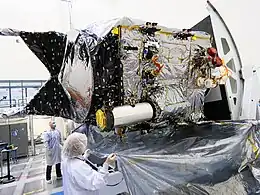
The spacecraft will also test an experimental laser communication technology called Deep Space Optical Communications (DSOC).[45] It is hoped that the device will increase spacecraft communications performance and efficiency by 10 to 100 times over conventional means.[45][46] The DSOC experiment is NASA's first demonstration of optical communications beyond the Earth-Moon system. DSOC is a system that consists of a flight laser transceiver, a ground laser transmitter, and a ground laser receiver. New technologies have been implemented in each of these elements. The transceiver is mounted on the Psyche spacecraft. The DSOC technology demonstration will begin shortly after launch and continue as the spacecraft travels from Earth to its gravity-assist flyby of Mars. DSOC operations are planned for one year after launch, with extended-mission opportunities to be evaluated. Palomar Observatory's Hale Telescope will receive the high-rate data downlink from the DSOC flight transceiver.[47][48]
The Discovery program solicitation offered mission projects an extra $30 M if they would host and test the 25 kg DSOC unit, which needs about 75 Watts.[49] It is hoped to advance DSOC to technology readiness level 6.[48] DSOC tests should begin about 60 days after launch. The test-runs of the laser equipment will occur over distances of 0.1 to 2.5 astronomical units (AU) on the outward-bound probe.[48]
Flight hardware
The DSOC flight laser transceiver will feature a near-infrared laser transmitter to send high-rate data to the ground system, and a sensitive photon-counting camera to receive a ground-transmitted laser. The transceiver's 8.6-inch (22-centimeter) aperture telescope is mounted on an assembly of struts and actuators that stabilizes the optics from spacecraft vibrations. The flight hardware is fitted with a sunshade and protrudes from the side of the spacecraft, making it one of Psyche's easily identifiable features.[47]
Ground systems
A high-power near-infrared laser transmitter at JPL's Table Mountain facility near Wrightwood, California, will uplink a modulated laser beam to the flight transceiver and demonstrate the transmission of low-rate data. The uplink laser will also act as a beacon for the flight transceiver to lock onto. The downlink data sent back by the DSOC transceiver on Psyche will be collected by the 200-inch (5.1-meter) Hale Telescope at Caltech's Palomar Observatory in San Diego County, California, using a sensitive superconducting nanowire photon-counting receiver to demonstrate high-rate data transfer.[47]
Operations
Launch and trajectory
.jpg.webp)
Psyche's launch period opened at October 5, 2023, with instantaneous launch windows every day until October 25.[50] On 28 September, NASA announced that the launch would be delayed by a week due to issues found with the spacecraft's thrusters, moving the launch date from October 5 to October 12.[51] The launch was delayed an additional day to October 13 due to bad weather.[52]
Psyche launched on October 13, 2023, at 10:19 am EDT, on a Falcon Heavy rocket from Launch Pad 39A at Kennedy Space Center.[53][17][15][5] This was the eighth Falcon Heavy launch, and the first one for NASA. The two side boosters used in the mission made their fourth flight; they landed back at Cape Canaveral a few minutes after liftoff, and will be reused on future flights, including the launch of Europa Clipper in 2024. The core stage of the rocket was expended. The Psyche spacecraft was released from the upper stage of the rocket about an hour after liftoff.[54][55] A carrier wave signal from the spacecraft was received by ground controllers just after separation, providing information on spacecraft status prior to solar array deployment.[56] Full communication with the spacecraft was established at 11:50 am EDT. The spacecraft then began a 100-day commissioning phase, during which all systems and instruments are tested and calibrated.[53]
The cost of the launch was US$117 million.[7] Psyche will conduct a gravity assist maneuver at Mars in 2026, which will position the spacecraft for arrival at the target asteroid in August 2029.[1]
Orbit regimes
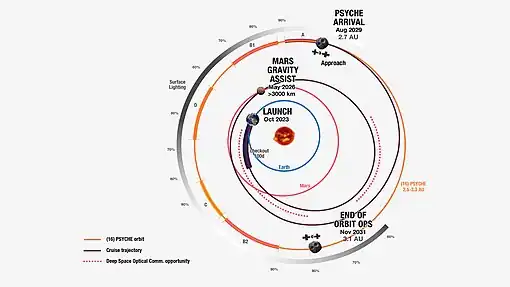
The approach sequence will begin in May 2029, when the first navigation images and measurements of 16 Psyche will be taken, the asteroid still just a few pixels wide. The spacecraft will then use its electric propulsion system to position itself to be captured by the asteroid's gravity, which is expected to occur in late July 2029. At this point, the first close-up images of 16 Psyche will be taken, with the asteroid appearing about 500 pixels across. Over the next 20 days the spacecraft will maneuver itself to enter the first of four science orbits.[50]
Psyche is scheduled to enter orbit around 16 Psyche in August 2029.[1] The spacecraft will orbit the asteroid at four different altitudes, which are named alphabetically from highest (A) to lowest (D). In the original mission plan, the spacecraft would progress through the orbits sequentially from highest to lowest.[39] After the 2022 launch delay, the mission plan was updated to reflect the new 2029 arrival date, which meant the spacecraft would arrive at the asteroid at a different point in its orbit around the Sun. In the new mission plan, Psyche will initially enter Orbit A, then descend to Orbit B1, then Orbit D, back out to Orbit C, and finally it will move out to Orbit B2 (the second portion of Orbit B). This redesign ensures that the asteroid's surface is correctly illuminated by the Sun during Orbit B.[57][58]
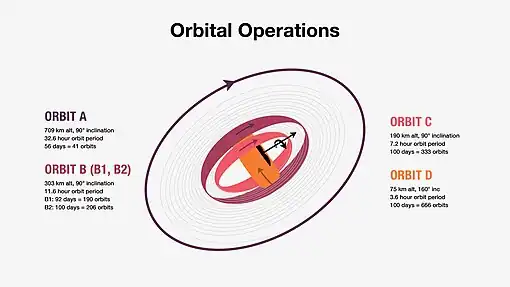
Its first regime, Orbit A, will see the spacecraft enter a 700 km (430 mi) orbit for magnetic field characterization and preliminary mapping for a duration of 56 days. It will then descend to Orbit B, set at 303 km (188 mi) altitude for 92 days, for topography and magnetic field characterization. It will then descend to Orbit D, which is the lowest orbit at 75 km (47 mi) and is also uniquely inclined to allow direct view of the asteroid's equator (compared to the other orbits that go around its poles), for 100 days to determine the chemical composition of the surface using its gamma-ray and neutron spectrometers. After that it will ascend to Orbit C at 190 km (120 mi) altitude for 100 days to perform gravity investigations and continue magnetic field observations. Finally, the orbiter will return to Orbit B for 100 days, to finish mapping the portion of the asteroid's surface that was under darkness during the first portion of Orbit B. It will also acquire continued imaging, gravity, and magnetic field mapping. In total, the prime mission is expected to last 26 months, ending in November 2031. At the end of the mission, the spacecraft will be left in orbit around the asteroid.[59][50][39][60]
| Orbit regime | Date (UTC) | Duration (day) | Orbital period (hour) | Altitude (km) | Inclination (degree) |
Transfer to next orbit (day) |
Mission |
|---|---|---|---|---|---|---|---|
| Orbit A | August 2029 | 56 | 32.8 | 700 | 90 | 17 | Magnetic field characterization and preliminary mapping |
| Orbit B1 | October 2029 | 92 | 11.6 | 303 | 90 | 98 | Topography and magnetic field characterization |
| Orbit D | May 2030 | 100 | 3.6 | 75 | 160 | Surface chemical composition determination | |
| Orbit C | January 2031 | 100 | 7.2 | 190 | 90 | Gravity investigations and Magnetic field observations | |
| Orbit B2 | May 2031 | 100 | 11.6 | 303 | 90 | Topography and magnetic field characterization |
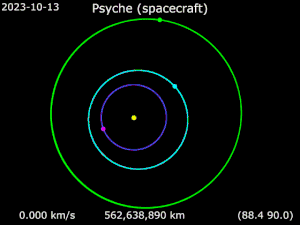
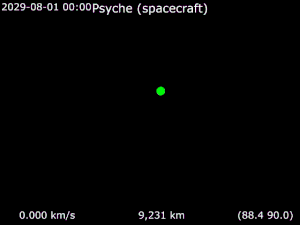
Ground stations for laser link
The laser beams from the spacecraft will be received by a ground telescope at Palomar Observatory in California.[48] Laser beams to the spacecraft will be sent from a smaller telescope at JPL Table Mountain Facility.[48]
Construction and pre-launch testing
Testing

Testing began on the spacecraft in December 2021. These tests included but were not limited to electromagnetic testing and TVAC, or thermal vacuum chamber testing. The electromagnetic testing was conducted to ensure that the electronics and magnetic components that make up the spacecraft will not interfere with each other while conducting the mission. The TVAC testing was conducted inside the 85- by 25-foot vacuum chamber at JPL's facility in Southern California, which replicates the lack of air in space. This allows for the engineers and scientist to observe the effects of the space environment on the orbiter. Inside the TVAC, the JPL employees can observe how well the spacecraft reacts to harsh conditions. Without air surrounding the spacecraft, the heating and cooling of the unit is affected. The spacecraft will be hot in the hours after launch, while it is still close to Earth and facing the Sun, especially with its electronics running, and later, when the spacecraft gets farther from the Sun, it faces intense cold, especially when flying in 16 Psyche's shadow. Vibration tests of the spacecraft by scientists and engineers ensure it can survive the extreme conditions of the rocket launch. They also performed shock testing to ensure the spacecraft could survive the shock of separation from the rocket's second stage. Finally, they performed acoustic testing on the craft. The sound of the launch can be so violent that it can damage the hardware, so intense acoustic testing was performed to ensure mission success.[61]
References
- "NASA Continues Psyche Asteroid Mission". JPL. NASA. October 28, 2022. Archived from the original on November 8, 2022. Retrieved October 28, 2022.
- "FY 2021 President's Budget Request Summary" (PDF). NASA. February 10, 2020. pp. 437–439. Archived (PDF) from the original on June 17, 2020. Retrieved February 22, 2020.
 This article incorporates text from this source, which is in the public domain.
This article incorporates text from this source, which is in the public domain. - Lord, Peter W.; van Ommering, Gerrit (2015). Evolved Commercial Solar Electric Propulsion: A Foundation for Major Space Exploration Missions (PDF). 31st Space Symposium, Technical Track, April 13–14, 2015, Colorado Springs, Colorado. Archived from the original (PDF) on January 7, 2018. Retrieved January 6, 2018.
- "Psyche: Journey to a Metallic World". Archived from the original on February 11, 2021. Retrieved February 9, 2021 – via www.youtube.com.
- Strickland, Ashley (October 13, 2023). "NASA launches a spacecraft to visit Psyche, an unseen metal world". CNN. Archived from the original on October 13, 2023. Retrieved October 13, 2023.
- Clark, Stephen (October 13, 2023). "NASA just launched the Psyche mission—no one knows what it will find". Ars Technica. Archived from the original on October 13, 2023. Retrieved October 13, 2023.
- Foust, Jeff (February 28, 2020). "Falcon Heavy to launch NASA Psyche asteroid mission". SpaceNews. Archived from the original on March 1, 2020. Retrieved February 29, 2020.
- Chang, Kenneth (January 6, 2017). "A Metal Ball the Size of Massachusetts That NASA Wants to Explore". The New York Times. Archived from the original on January 7, 2017. Retrieved March 3, 2017.
- Grush, Loren (January 4, 2017). "In the 2020s NASA will launch spacecraft to study Jupiter's asteroids, and another made of metal". The Verge. Archived from the original on January 5, 2017. Retrieved September 8, 2017.
- Dinner, Josh (October 13, 2023). "SpaceX Falcon Heavy rocket launches NASA's Psyche probe to bizarre metal asteroid (video)". Space.com. Archived from the original on October 18, 2023. Retrieved October 18, 2023.
- Brown, Dwayne C.; Cantillo, Laurie (September 30, 2015). "NASA Selects Investigations for Future Key Planetary Mission". NASA. Archived from the original on August 9, 2020. Retrieved October 1, 2015.
 This article incorporates text from this source, which is in the public domain.
This article incorporates text from this source, which is in the public domain. - Brown, Dwayne C.; Cantillo, Laurie (January 4, 2017). "NASA Selects Two Missions to Explore the Early Solar System". NASA. Archived from the original on June 17, 2019. Retrieved January 4, 2017.
 This article incorporates text from this source, which is in the public domain.
This article incorporates text from this source, which is in the public domain. - Mathewson, Samantha (March 2, 2020). "NASA picks SpaceX Falcon Heavy to launch Psyche mission to metal asteroid in 2022". SPACE.com. Archived from the original on August 9, 2020. Retrieved May 22, 2020.
- "NASA Announces Launch Delay for Its Psyche Asteroid Mission". NASA Jet Propulsion Laboratory (JPL). Archived from the original on June 24, 2022. Retrieved June 24, 2022.
- "Psyche". NASA Jet Propulsion Laboratory (JPL) - Robotic Space Exploration. NASA/JPL-Caltech. Archived from the original on March 2, 2022. Retrieved April 27, 2023.
- "Launch of NASA's Psyche asteroid mission slips a week due to spacecraft issue". spaceflightnow.com. September 28, 2023. Archived from the original on September 29, 2023. Retrieved September 28, 2023.
- "Bad weather delays SpaceX Falcon Heavy launch of NASA's Psyche asteroid mission to Oct. 13". Space.com. October 12, 2023. Archived from the original on October 12, 2023. Retrieved October 12, 2023.
- Foust, Jeff (November 5, 2022). "Psyche review finds institutional problems at JPL". Space News. Archived from the original on October 16, 2023. Retrieved March 17, 2023.
- Elkins-Tanton, L. T.; et al. (2014). Journey to a Metal World: Concept for a Discovery Mission to Psyche (PDF). 45th Lunar and Planetary Science Conference March 17–24, 2014 The Woodlands, Texas. 1253. Bibcode:2014LPI....45.1253E. LPI Contribution No. 1777. Archived (PDF) from the original on February 27, 2014. Retrieved October 1, 2015.
- Elkins-Tanton, L. T.; et al. (2020). "Observations, meteorites, and models: A preflight assessment of the composition and formation of (16) Psyche". Journal of Geophysical Research: Planets. 125 (3): 23. Bibcode:2020JGRE..12506296E. doi:10.1029/2019JE006296. PMC 7375145. PMID 32714727. S2CID 214018872.
- Shepard, Michael K.; De Kleer, Katherine; Cambioni, Saverio; Taylor, Patrick A.; Virkki, Anne K.; Rívera-Valentin, Edgard G.; Rodriguez Sanchez-Vahamonde, Carolina; Fernanda Zambrano-Marin, Luisa; Magri, Christopher; Dunham, David; Moore, John; Camarca, Maria (2021). "Asteroid 16 Psyche: Shape, Features, and Global Map". The Planetary Science Journal. 2 (4): 125. arXiv:2110.03635. Bibcode:2021PSJ.....2..125S. doi:10.3847/PSJ/abfdba. S2CID 235918955.
- Shepard, Michael K. (January 2017). "Radar observations and shape model of asteroid 16 Psyche". Icarus. 281: 388–403. Bibcode:2017Icar..281..388S. doi:10.1016/j.icarus.2016.08.011.
- Agle, D. C.; Russell, Jimi; Cantillo, Laurie; Brown, Dwayne (September 28, 2017). "NASA Glenn Tests Thruster Bound for Metal World". NASA. Archived from the original on April 12, 2020. Retrieved January 6, 2018.
 This article incorporates text from this source, which is in the public domain.
This article incorporates text from this source, which is in the public domain. - Kane, Van (February 19, 2014). "Mission to a Metallic World: A Discovery Proposal to Fly to the Asteroid Psyche". The Planetary Society. Archived from the original on October 4, 2015. Retrieved October 1, 2015.
- Wampler, Stephen (November 4, 2015). "Lab-Johns Hopkins team tapped to work on possible NASA effort to explore asteroid". Lawrence Livermore National Laboratory. Archived from the original on August 9, 2020. Retrieved December 21, 2015.
 This article incorporates text from this source, which is in the public domain.
This article incorporates text from this source, which is in the public domain. - Lewis, Wendy (October 26, 2015). "SSL is JPL Industrial Partner for NASA Asteroid Exploration Mission Opportunity". SSL (company). Archived from the original on August 9, 2020. Retrieved January 4, 2017.
- Dorminey, Bruce (March 10, 2019). "Proposed NASA SmallSat Mission Could Be First To Visit Pallas, Our Third Largest Asteroid". Forbes. Archived from the original on August 9, 2020. Retrieved March 10, 2019.
- The EscaPADE smallsat mission to study the Martian atmosphere has passed PDR, but won't launch with Psyche as originally planned; will be remanifested on a future flight Archived September 14, 2020, at the Wayback Machine Jeff Foust, SpaceNews, September 14, 2020
- "Janus Mission Removed from 2023 Psyche Launch Manifest – Janus". blogs.nasa.gov. November 18, 2022. Archived from the original on November 25, 2022. Retrieved November 20, 2022.
- "Navigation Models for Psyche Electric Propulsion Uncertainty" (PDF). NASA/Caltech/JPL. Archived (PDF) from the original on April 30, 2022. Retrieved April 30, 2022.
- "Psyche". NASA Jet Propulsion Laboratory (JPL). Archived from the original on March 2, 2022. Retrieved April 27, 2023.
- "Development of the Psyche Mission for NASA's Discovery Program" (PDF). Archived from the original (PDF) on June 24, 2018.
- Myers, Roger. "Solar Electric Propulsion: Introduction, Applications and Status" (PDF). Aerojet Rocketdyne. Archived (PDF) from the original on January 7, 2018. Retrieved January 6, 2018.
- Johnson, Ian K.; Kay, Ewan; Lee, Ty; Bae, Ryan; Feher, Negar (2017). New Avenues for Research and Development of Electric Propulsion Thrusters at SSL (PDF). 35th International Electric Propulsion Conference October 8–12, 2017 Atlanta, Georgia. IEPC-2017-400. Archived from the original (PDF) on January 7, 2018. Retrieved January 6, 2018.
- Greicius, Tony (September 20, 2021). "Solar Electric Propulsion Makes NASA's Psyche Spacecraft Go". NASA. Archived from the original on April 7, 2022. Retrieved May 11, 2022.
- Cole, Michael (October 9, 2017). "NASA Glenn tests solar electric propulsion thruster for journey to metal world". Spaceflight Insider. Archived from the original on January 7, 2018. Retrieved January 6, 2018.
- DeFelice, David (August 18, 2015). "NASA – Ion Propulsion". NASA. Archived from the original on December 31, 2018. Retrieved January 20, 2018.
 This article incorporates text from this source, which is in the public domain.
This article incorporates text from this source, which is in the public domain. - "T-140". University of Michigan Plasmadynamics & Electric Propulsion Laboratory. Archived from the original on June 17, 2018. Retrieved January 6, 2018.
- Oh, David Y.; Collins, Steve; Goebel, Dan; Hart, Bill; Lantoine, Gregory; Snyder, Steve; Whiffen, Greg; Elkins-Tanton, Linda; Lord, Peter; Pirkl, Zack; Rotlisburger, Lee (2017). Development of the Psyche Mission for NASA's Discovery Program (PDF). 35th International Electric Propulsion Conference, October 8–12, 2017, Atlanta, Georgia. IEPC-2017-153. Archived from the original (PDF) on June 24, 2018. Retrieved January 7, 2018.
- "Native Electric Propulsion Engines Today" (in Russian). Novosti Kosmonavtiki. 1999. Archived from the original on June 6, 2011.
- Delgado, Jorge J.; Corey, Ronald L.; Murashko, Vjacheslav M.; Koryakin, Alexander I.; Pridanikov, Sergei Y. (2014). Qualification of the SPT-140 for use on Western Spacecraft. 50th AIAA/ASME/SAE/ASEE Joint Propulsion Conference, July 28–30, 2014, Cleveland, Ohio. doi:10.2514/6.2014-3606. AIAA 2014–3606.
- "SPT-140 | UM PEPL". Retrieved October 20, 2023.
- Solar Electric Propulsion Makes NASA's Psyche Spacecraft Go, JPL, September 20, 2021, archived from the original on October 14, 2023, retrieved October 14, 2023
- Agle, D. C.; Valentine, Karin; Cantillo, Laurie; Brown, Dwayne C. (May 24, 2017). "NASA Moves Up Launch of Psyche Mission to a Metal Asteroid". NASA. Archived from the original on December 2, 2020. Retrieved January 6, 2018.
 This article incorporates text from this source, which is in the public domain.
This article incorporates text from this source, which is in the public domain. - David, Leonard (October 18, 2017). "Deep Space Communications via Faraway Photons". NASA / Jet Propulsion Laboratory. Archived from the original on January 11, 2020. Retrieved October 19, 2017.
 This article incorporates text from this source, which is in the public domain.
This article incorporates text from this source, which is in the public domain. - Greicius, Tony (September 14, 2017). "Psyche Overview". NASA. Archived from the original on November 10, 2021. Retrieved September 18, 2017.
 This article incorporates text from this source, which is in the public domain.
This article incorporates text from this source, which is in the public domain. - Harbaugh, Jennifer (May 22, 2017). "Deep Space Optical Communications (DSOC)". NASA. Archived from the original on May 7, 2022. Retrieved May 11, 2022.
 This article incorporates text from this source, which is in the public domain.
This article incorporates text from this source, which is in the public domain. - Hall, Loura, ed. (October 18, 2017). ""Lighten Up" – Deep Space Communications via Faraway Photons". NASA. Archived from the original on April 10, 2019. Retrieved January 6, 2018.
 This article incorporates text from this source, which is in the public domain.
This article incorporates text from this source, which is in the public domain. - "NASA Drops Laser Comm Requirement From Discovery Solicitation". SpaceNews. November 6, 2014. Archived from the original on October 16, 2023. Retrieved November 28, 2021.
- "Psyche Press Kit – Mission". NASA Jet Propulsion Laboratory (JPL). September 29, 2023. Archived from the original on October 14, 2023. Retrieved October 13, 2023.
- "NASA delays Psyche launch a week". spacenews.com. September 29, 2023. Archived from the original on October 16, 2023. Retrieved October 14, 2023.
- "Weather Delays NASA's Psyche Launch, Now Targeting Oct. 13". NASA Blogs - Psyche Mission. October 11, 2023. Archived from the original on October 12, 2023. Retrieved October 14, 2023.
- "NASA's Psyche Spacecraft, Optical Comms Demo En Route to Asteroid". NASA. Archived from the original on October 14, 2023. Retrieved October 14, 2023.
- "NASA just launched the Psyche mission—no one knows what it will find". arstechnica.com. October 13, 2023. Archived from the original on October 13, 2023. Retrieved October 14, 2023.
- "NASA launches Psyche mission to metal world". spacenews.com. October 13, 2023. Archived from the original on October 16, 2023. Retrieved October 14, 2023.
- "Psyche Spacecraft Separates From Falcon Heavy Second Stage". NASA Blogs – Psyche Mission. October 13, 2023. Archived from the original on October 14, 2023. Retrieved October 14, 2023.
- "The Road to October 2023: NASA's Psyche Has an Updated Mission Plan". NASA Blogs – Psyche Mission. March 29, 2023. Archived from the original on September 7, 2023. Retrieved October 14, 2023.
- "Psyche Orbital Operations". NASA Jet Propulsion Laboratory (JPL). Archived from the original on September 3, 2023. Retrieved September 3, 2023.
- "Psyche Orbital Operations". JPL, NASA. Archived from the original on September 3, 2023. Retrieved September 3, 2023.
- "Psyche". NSSDC. NASA. Archived from the original on June 16, 2020. Retrieved October 28, 2022.
- Greicius, Tony (April 3, 2022). "Shake and Bake: NASA's Psyche Is Tested in Spacelike Conditions". NASA. Archived from the original on May 26, 2022. Retrieved May 12, 2022.
Further reading
- Zuber, Maria T.; Park, Ryan S.; Elkins-Tanton, Linda T.; Bell, J. F.; Bruvold, Kristoffer N.; Bercovici, David; Bills, Bruce G.; Binzel, Richard P.; Jaumann, R.; Marchi, Simone; Raymond, Carol A.; Roatsch, T.; Wang, Charles C.; Weiss, Benjamin P.; Wenkert, Daniel; Wieczorek, Mark A. (October 18, 2022). "The Psyche Gravity Investigation". Space Science Reviews. 218 (8): 57. Bibcode:2022SSRv..218...57Z. doi:10.1007/s11214-022-00905-3. ISSN 1572-9672. S2CID 252922565. Retrieved August 29, 2023.
External links
- Mission website at NASA.gov
- Mission website by Arizona State University

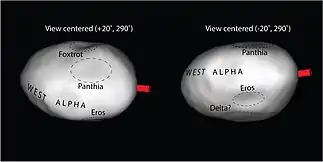




.jpg.webp)
.png.webp)

.jpg.webp)
.jpg.webp)